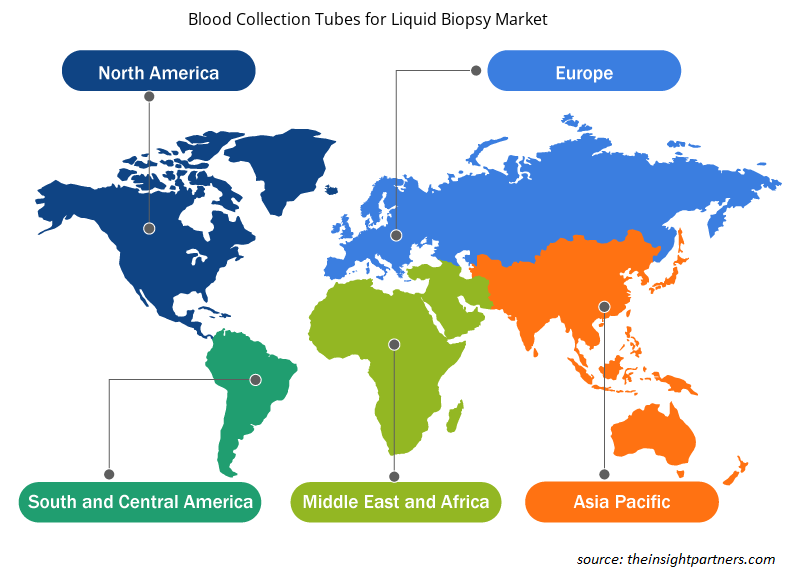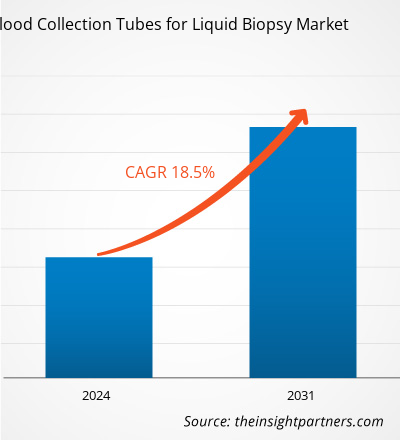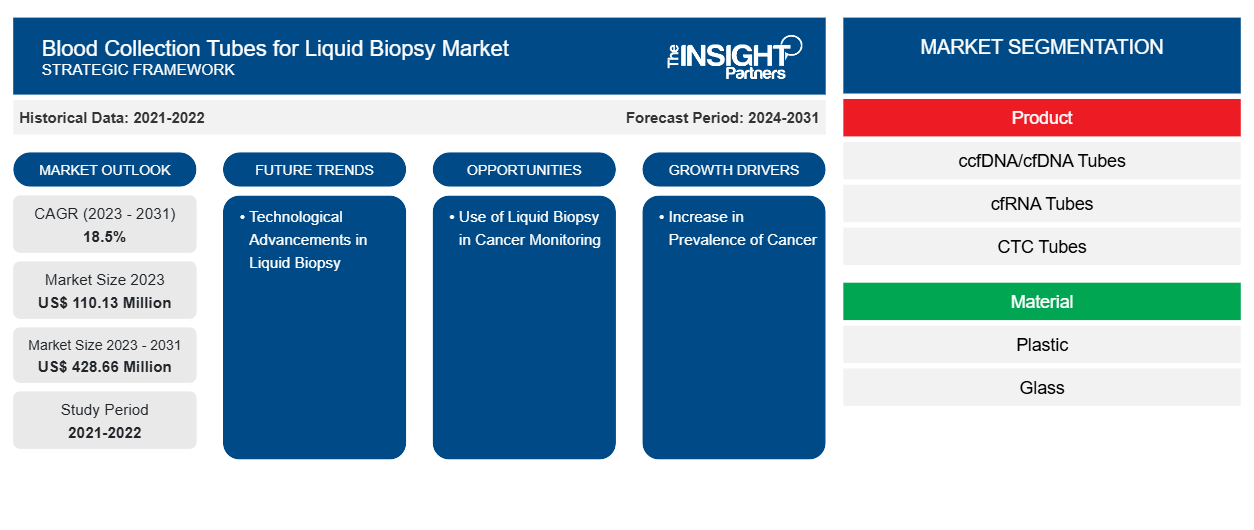Der Markt für Blutentnahmeröhrchen für die Flüssigbiopsie soll von 110,13 Millionen US-Dollar im Jahr 2023 auf 428,66 Millionen US-Dollar im Jahr 2031 anwachsen. Der Markt soll zwischen 2023 und 2031 eine durchschnittliche jährliche Wachstumsrate (CAGR) von 18,5 % verzeichnen. Angesichts der zunehmenden Zahl chronischer Krankheiten, die Blutuntersuchungen zur Diagnose und Überwachung des Krankheitsverlaufs erfordern, dürften technologisch fortschrittliche Blutentnahmeröhrchen für die Flüssigbiopsie weiterhin wichtige Trends auf dem Markt bleiben.
Blutentnahmeröhrchen für die Flüssigbiopsie Marktanalyse
Einer der Haupttreiber für das Wachstum des Marktes für Blutentnahmeröhrchen für Flüssigbiopsien ist die zunehmende Verbreitung von Krebs sowie die steigende Nachfrage nach nichtinvasiven Diagnoseinstrumenten. Der Markt für Blutentnahmeröhrchen für Flüssigbiopsien wächst auch aufgrund laufender Forschungs- und Entwicklungsaktivitäten zur Entwicklung neuer Biomarker zur Früherkennung von Krankheiten. Die Entwicklung von Durchsatz-Blutentnahmeröhrchen weist auf eine deutliche Verbesserung der Blutentnahmeröhrchen für Flüssigbiopsieverfahren hin.
Blutentnahmeröhrchen für die Flüssigbiopsie Marktübersicht
Angesichts der steigenden Zahl an Krebserkrankungen steigt in Indien die Nachfrage nach hochentwickelten, weniger invasiven Diagnoseverfahren wie Flüssigbiopsien. Diese Verfahren können aufgrund ihrer minimalinvasiven Natur häufiger durchgeführt werden als herkömmliche Gewebebiopsien. Daher wächst der Markt für Blutentnahmeröhrchen für Flüssigbiopsien in Indien erheblich, da die Zahl der im Land durchgeführten Flüssigbiopsieverfahren stark zunimmt. Laut dem Indian Council of Medical Research wurden im Jahr 2022 in Indien schätzungsweise 1,46 Millionen neue Krebsfälle diagnostiziert . In Indien wird erwartet, dass jeder neunte Mensch im Laufe seines Lebens eine Krebsdiagnose erhält. Brustkrebs ist die häufigste Krebsart bei Frauen, während Lungenkrebs bei Männern die häufigste Art ist. Lymphatische Leukämie erwies sich als die häufigste Krebsart bei Kindern und betrifft 29,2 % der Jungen und 24,2 % der Mädchen im Alter von 0–14 Jahren. Laufende Fortschritte wie verbesserte Erkennungstechniken und empfindlichere Geräte machen Flüssigbiopsieverfahren zuverlässiger und zugänglicher. Darüber hinaus ist zu erwarten, dass das zunehmende Bewusstsein für die Vorteile der Flüssigbiopsie, zu denen Früherkennung, Überwachung der Behandlungswirksamkeit und Rückfallprävention gehören, dem Markt in Entwicklungsländern wie Indien in den kommenden Jahren zugute kommen wird.
Passen Sie diesen Bericht Ihren Anforderungen an
Sie erhalten kostenlose Anpassungen an jedem Bericht, einschließlich Teilen dieses Berichts oder einer Analyse auf Länderebene, eines Excel-Datenpakets sowie tolle Angebote und Rabatte für Start-ups und Universitäten.
-
Holen Sie sich die wichtigsten Markttrends aus diesem Bericht.Dieses KOSTENLOSE Beispiel umfasst eine Datenanalyse von Markttrends bis hin zu Schätzungen und Prognosen.
Blutentnahmeröhrchen für Flüssigbiopsie – Markttreiber und Chancen
Vorteile der Flüssigbiopsie gegenüber anderen diagnostischen Testverfahren fördern Marktwachstum
Invasive Diagnoseverfahren erhöhen das Risiko von Hämatomen , Blutungen und Gewebeschäden, wodurch Tumorzellen in das umliegende Gewebe gelangen. Daher bevorzugen Patienten zu Diagnosezwecken zunehmend nicht- oder minimal-invasive Tests. Durch die Flüssigbiopsie von Blutproben können Forscher alle genetischen und epigenetischen Veränderungen in soliden Tumoren zurückverfolgen. Da es sich bei der Flüssigbiopsie um eine nicht-invasive Diagnosetechnik handelt, ist das Risiko für Patienten geringer. Außerdem können Ärzte diese Tests problemlos mehrmals durchführen, da die Verfahren für die Patienten nicht sehr unangenehm sind. Patienten bevorzugen minimal-invasive Verfahren aufgrund der Verwendung moderner Instrumente, die es Ärzten oder Laborpersonal ermöglichen, feinfühligere und komplexere Arbeiten ohne große Schmerzen, Narbenbildung und andere Risiken durchzuführen. Die Flüssigbiopsie hat in letzter Zeit als nicht-invasive Alternative zur Gewebebiopsie bei Krebspatienten erhebliches Interesse geweckt, da technische Fortschritte zu einer verbesserten Durchführbarkeit und kürzeren Verarbeitungszeiten beitragen.
Computertomographie (CT), Magnetresonanztomographie (MRT) und Positronen-Emissions-Tomographie (PET) sind neben anderen bildgebenden Verfahren teuer und zeitaufwändig. Außerdem werden die Patienten dabei u. a. externer Strahlung, intravenösen Kontrastmitteln und radioaktiven Tracern ausgesetzt. Bildgebende Verfahren liefern auch keine Informationen über den Phänotyp des Tumors, der sich je nach Behandlung ändern kann. Obwohl Gewebebiopsieverfahren Informationen über den Tumorphänotyp liefern können, ist es aufgrund der Kostenbeschränkungen und der Risiken für die Patienten nicht praktikabel, serielle Gewebebiopsien durchzuführen. Die Flüssigbiopsie hingegen könnte eine nahezu kontinuierliche Bewertung der Krebslast und von Phänotypinformationen zu relativ geringen Kosten liefern. Die Flüssigbiopsie bietet nichtinvasive oder minimalinvasive Möglichkeiten zur Bewertung verschiedener physiologischer oder pathophysiologischer Prozesse und ersetzt so die Gewebebiopsie oder andere invasive Verfahren. In diesem Fall könnte die Flüssigbiopsie die Notwendigkeit einer Endoskopie, Nadelbiopsie oder Operation umgehen, indem sie eine Blutprobe auf zirkulierende Tumorzellen oder zirkulierende freie Nukleinsäuren analysiert.
Der Einsatz von Flüssigbiopsien zur Krebsüberwachung bietet Wachstumschancen für den Markt
Forscher untersuchen derzeit intensiv, ob sich mithilfe von Flüssigbiopsieverfahren das Krebswachstum überwachen, genetische Mutationen erkennen, Anzeichen eines Rückfalls identifizieren und die Empfindlichkeit gegenüber einer Immuntherapie vorhersagen lassen . Eine frühzeitige Krebserkennung führt zu besseren Ergebnissen. So weisen Patienten mit frühzeitiger Erkennung beispielsweise höhere Remissions- und Überlebensraten auf als Patienten mit Krebs im Spätstadium oder bösartigem Krebs. Allerdings ist es nicht praktikabel, fortlaufende radiologische Tests oder invasive Verfahren zur Krebsüberwachung durchzuführen, um Krebs im Frühstadium zu erkennen, wenn keine Symptome erkennbar sind. Die Flüssigbiopsie eröffnet die Möglichkeit regelmäßiger Krebsvorsorgeuntersuchungen durch routinemäßige Blutentnahmen oder Urinanalysen. Sie kann hochspezifische und zirkulierende Marker für eine frühzeitige Krebserkennung identifizieren.
Flüssigbiopsieverfahren werden auch zur Nachbehandlungsüberwachung von Krebspatienten eingesetzt. Krebszellen können nach der Behandlung in Konzentrationen unterhalb der Auflösungs- und Nachweisgrenzen bildgebender Verfahren im Körper verbleiben; dieser Zustand wird als minimale Resterkrankung bezeichnet. Diese Krankheit gilt als Hauptursache für die Remission von Krebs. Ähnlich wie bei der Krebsvorsorge und Früherkennung ist die klinische Anwendung der Flüssigbiopsie durch die Sensitivität und Spezifität der derzeitigen Tests begrenzt. Diese Sensibilitätsbeschränkung macht Flüssigbiopsietechniken besser geeignet zum Nachweis minimaler Resterkrankungen bei soliden Tumoren als bei Blutkrebs. Mithilfe der Flüssigbiopsie kann das medizinische Fachpersonal das Wiederauftreten von Krebs überwachen, der dann mithilfe einer geeigneten Diagnose frühzeitig behandelt werden kann.
Tumore, die zunächst anfällig für bestimmte Tyrosinkinasehemmer wie Gefitinib , Erlotinib , Crizotinib und Ceritinib sind, mutieren häufig und entwickeln eine Resistenz gegen diese Medikamente. Mithilfe der Flüssigbiopsie lassen sich Veränderungen des Tumorstatus erkennen und Ärzte können die Behandlungsstrategien anpassen, um die Entwicklung einer Resistenz gegen Medikamente im Körper des Patienten zu vermeiden. Auf diese Weise ermöglicht die Flüssigbiopsie eine frühzeitige Krebserkennung und hilft medizinischem Fachpersonal, die genaue Behandlungsstrategie festzulegen. Darüber hinaus hilft sie bei der Überwachung der Behandlung und des Zustands des Patienten nach der Behandlung. Daher rückt der Einsatz der Flüssigbiopsie bei der Überwachung von Krebspatienten zunehmend in den Fokus, was im Prognosezeitraum wahrscheinlich zu einer erheblichen Nachfrage nach Blutentnahmeröhrchen für Flüssigbiopsieverfahren führen wird.
Blutentnahmeröhrchen für die Flüssigbiopsie Marktbericht Segmentierungsanalyse
Wichtige Segmente, die zur Ableitung der Marktanalyse für Blutentnahmeröhrchen für die Flüssigbiopsie beigetragen haben, sind Produkt, Material, Anwendung und Endbenutzer.
- Basierend auf dem Produkt ist der Markt für Blutentnahmeröhrchen für die Flüssigbiopsie in ccfDNA- Röhrchen, cfRNA- Röhrchen, CTC- Röhrchen, gDNA- Röhrchen, intrazelluläre RNA-Röhrchen und andere unterteilt. Das Segment ccfDNA- / cfDNA- Röhrchen hatte im Jahr 2023 den größten Marktanteil.
- Basierend auf dem Material ist der Markt für Blutentnahmeröhrchen für die Flüssigbiopsie in Glas und Kunststoff unterteilt. Das Kunststoffsegment hatte im Jahr 2023 einen größeren Marktanteil.
- Nach Anwendung ist der Markt in In-vitro-Diagnostik (IVD) und Forschung unterteilt. Das Segment In-vitro-Diagnostik (IVD) hielt im Jahr 2023 einen größeren Marktanteil.in-vitro diagnostics (IVD) and research. The in-vitro diagnostics (IVD) segment held a larger share of the market in 2023.
- Basierend auf dem Endverbraucher ist der Markt für Blutentnahmeröhrchen für die Flüssigbiopsie in genetische Diagnoselabore, F&E-Zentren, konventionelle Diagnosezentren und andere unterteilt. Das Segment der genetischen Diagnoselabore hatte im Jahr 2023 den größten Marktanteil.
Blutentnahmeröhrchen für die Flüssigbiopsie Marktanteilsanalyse nach Geografie
Der geografische Umfang des Marktberichts zu Blutentnahmeröhrchen für die Flüssigbiopsie ist hauptsächlich in fünf Regionen unterteilt: Nordamerika, Asien-Pazifik, Europa, Süd- und Mittelamerika sowie Naher Osten und Afrika. Nordamerika dominierte den Markt im Jahr 2023. Die wachsende Akzeptanz technologisch fortschrittlicher Produkte, ein Anstieg der Forschungs- und Entwicklungsaktivitäten, die Präsenz großer Gesundheitsunternehmen und die zunehmende Zahl von Zulassungen der FDA für Flüssigbiopsien gehören zu den Schlüsselfaktoren, die den Markt für Blutentnahmeröhrchen für die Flüssigbiopsie in Nordamerika stärken. Der asiatisch-pazifische Raum wird im Prognosezeitraum voraussichtlich die höchste CAGR verzeichnen. Der Markt für Flüssigbiopsieverfahren wächst in den USA aufgrund der steigenden Krebsrate, der hohen Ausgaben für die Entwicklung innovativer Diagnoselösungen und der Präsenz bedeutender Marktteilnehmer.CAGR during the forecast period. The market for liquid biopsy procedures is proliferating in the US with the surging prevalence of cancer, high spending on the development of innovative diagnostics solutions, and the presence of significant market players.
Blutentnahmeröhrchen für die Flüssigbiopsie Marktregionale Einblicke
Die regionalen Trends und Faktoren, die den Markt für Blutentnahmeröhrchen für Flüssigbiopsien während des Prognosezeitraums beeinflussen, wurden von den Analysten von Insight Partners ausführlich erläutert. In diesem Abschnitt werden auch die Marktsegmente und die Geografie für Blutentnahmeröhrchen für Flüssigbiopsien in Nordamerika, Europa, im asiatisch-pazifischen Raum, im Nahen Osten und Afrika sowie in Süd- und Mittelamerika erörtert.

- Erhalten Sie regionale Daten zum Markt für Blutentnahmeröhrchen für die Flüssigbiopsie
Umfang des Marktberichts zu Blutentnahmeröhrchen für die Flüssigbiopsie
| Berichtsattribut | Details |
|---|---|
| Marktgröße im Jahr 2023 | 110,13 Millionen US-Dollar |
| Marktgröße bis 2031 | 428,66 Millionen US-Dollar |
| Globale CAGR (2023 - 2031) | 18,5 % |
| Historische Daten | 2021-2022 |
| Prognosezeitraum | 2024–2031 |
| Abgedeckte Segmente |
Nach Produkt
|
| Abgedeckte Regionen und Länder |
Nordamerika
|
| Marktführer und wichtige Unternehmensprofile |
|
Dichte der Marktteilnehmer für Blutentnahmeröhrchen für die Flüssigbiopsie: Verständnis ihrer Auswirkungen auf die Geschäftsdynamik
Der Markt für Blutentnahmeröhrchen für Flüssigbiopsien wächst rasant, angetrieben von der steigenden Nachfrage der Endnutzer aufgrund von Faktoren wie sich entwickelnden Verbraucherpräferenzen, technologischen Fortschritten und einem größeren Bewusstsein für die Vorteile des Produkts. Mit steigender Nachfrage erweitern Unternehmen ihr Angebot, entwickeln Innovationen, um die Bedürfnisse der Verbraucher zu erfüllen, und nutzen neue Trends, was das Marktwachstum weiter ankurbelt.
Die Marktteilnehmerdichte bezieht sich auf die Verteilung der Firmen oder Unternehmen, die in einem bestimmten Markt oder einer bestimmten Branche tätig sind. Sie gibt an, wie viele Wettbewerber (Marktteilnehmer) in einem bestimmten Marktraum im Verhältnis zu seiner Größe oder seinem gesamten Marktwert präsent sind.
Die wichtigsten Unternehmen auf dem Markt für Blutentnahmeröhrchen für die Flüssigbiopsie sind:
- Biocept Inc
- F. Hoffmann-La Roche Ltd
- Streck Inc
- Norgen Biotek Corp
- Exact Sciences Corp
- MagBio Genomics Inc
Haftungsausschluss : Die oben aufgeführten Unternehmen sind nicht in einer bestimmten Reihenfolge aufgeführt.

- Überblick über die wichtigsten Akteure auf dem Markt für Blutentnahmeröhrchen für die Flüssigbiopsie
Blutentnahmeröhrchen für die Flüssigbiopsie – Marktnachrichten und aktuelle Entwicklungen
Der Markt für Blutentnahmeröhrchen für die Flüssigbiopsie wird durch die Erhebung qualitativer und quantitativer Daten nach Primär- und Sekundärforschung bewertet, die wichtige Unternehmensveröffentlichungen, Verbandsdaten und Datenbanken umfasst. Eine der wichtigsten Entwicklungen auf dem Markt, die in den letzten Jahren stattgefunden hat, ist nachstehend aufgeführt:
- Exact Science Corporation hat seine Haystack Oncology-Einrichtung in Baltimore, Maryland, angekündigt. Das neue Unternehmen hat kürzlich 56 Millionen US-Dollar an Finanzmitteln unter der Leitung der in New York ansässigen Investmentfirma Catalio Capital Management aufgebracht. Haystack entwickelt einen Bluttest, der Spuren zirkulierender DNA aus soliden Tumoren nachweisen kann und so das Vorhandensein von Krebs und dessen mögliches Wiederauftreten anzeigt. (Quelle: Exact Science Corporation, Unternehmenswebsite, November 2022)
Marktbericht zu Blutentnahmeröhrchen für die Flüssigbiopsie – Umfang und Ergebnisse
Der Bericht „Marktgröße und Prognose für Blutentnahmeröhrchen für die Flüssigbiopsie (2021–2031)“ bietet eine detaillierte Analyse des Marktes, die die folgenden Bereiche abdeckt:
- Blutentnahmeröhrchen für die Flüssigbiopsie Marktgröße und Prognose auf globaler, regionaler und Länderebene für alle wichtigen Marktsegmente, die im Rahmen des Berichts abgedeckt sind
- Blutentnahmeröhrchen für die Flüssigbiopsie – Markttrends sowie Marktdynamik wie Treiber, Einschränkungen und wichtige Chancen
- Detaillierte PEST/Porters Five Forces- und SWOT-Analyse
- Marktanalyse für Blutentnahmeröhrchen für die Flüssigbiopsie mit Abdeckung wichtiger Markttrends, globaler und regionaler Rahmenbedingungen, wichtiger Akteure, Vorschriften und aktueller Marktentwicklungen
- Branchenlandschaft und Wettbewerbsanalyse, die die Marktkonzentration, Heatmap-Analyse, prominente Akteure und aktuelle Entwicklungen auf dem Markt für Blutentnahmeröhrchen für die Flüssigbiopsie umfasst
- Detaillierte Firmenprofile
- Historische Analyse (2 Jahre), Basisjahr, Prognose (7 Jahre) mit CAGR
- PEST- und SWOT-Analyse
- Marktgröße Wert/Volumen – Global, Regional, Land
- Branchen- und Wettbewerbslandschaft
- Excel-Datensatz
Aktuelle Berichte
Verwandte Berichte
Erfahrungsberichte
Grund zum Kauf
- Fundierte Entscheidungsfindung
- Marktdynamik verstehen
- Wettbewerbsanalyse
- Kundeneinblicke
- Marktprognosen
- Risikominimierung
- Strategische Planung
- Investitionsbegründung
- Identifizierung neuer Märkte
- Verbesserung von Marketingstrategien
- Steigerung der Betriebseffizienz
- Anpassung an regulatorische Trends























 Kostenlose Probe anfordern für - Blutentnahmeröhrchen für den Markt für Flüssigbiopsien
Kostenlose Probe anfordern für - Blutentnahmeröhrchen für den Markt für Flüssigbiopsien